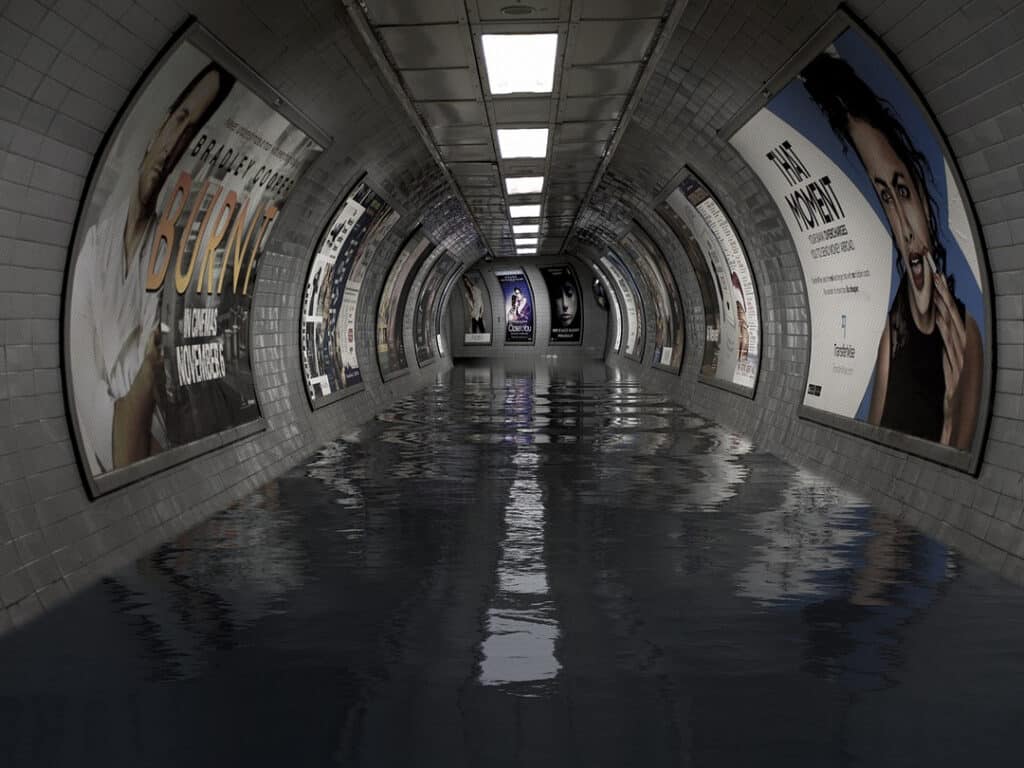Weather is one thing we just love to talk about in the UK. It can seem that the weather is rarely perfect, we often complain that it’s either too hot, too cold, too windy, too wet and with climate change, the weather is only getting more extreme.
The rail network can suffer in times of extreme weather with speed restrictions and replacement services leading to delays. However, with many opting to leave their car or bike at home during episodes of extreme weather the rail network can be busier than usual.
Extreme hot weather and the railway
Delays caused by overheated rails
In hot weather the railway lines can buckle with the train track reaching up to 20 degrees hotter than the air temperature. Buckling rails are misshapen and are no longer safe for trains to travel along.
Network Rail teams are prepared to respond quickly in the case of excessive heat, sections of track that notoriously overheat are painted white. Speed restrictions are often introduced in order to reduce the stress on the railway line although this could reduce the number of trains running. Track maintenance is carried out throughout the winter and Network Rail regularly repairs rails to prevent issues in the warmer months.
If rails do buckle in hot weather then that section of track will need to be shut whilst it is repaired. Although this will inevitably lead to delays and rail replacement services, train operators will do their best to minimise disruption to services. You can read more about how Network Rail deal with and prevent buckling tracks on their website.
Delays caused by overheated overhead power lines
38% of the national rail network is now electrified and, according to Network Rail, almost 66% of the electrified railway uses overhead lines. These overhead lines can be significantly affected by excessive heat, disrupting train services.
During a heatwave these overhead electrified lines can expand and sag and train services will need to be diverted until the lines are fixed. In order to prevent damage during hot weather trains need to travel more slowly, again this can lead to delays.
Extreme cold weather and the railway
Ice and snow can cause just as much chaos on the railway as high heat:
- Ice can coat the overhead lines preventing the electric trains from running.
- Ice on the tracks can affect braking and acceleration of trains.
- Ice can freeze solid the equipment that allows trains to change tracks.
- Trains are unable to run if there are heavy drifts of snow on the tracks unless they have snow ploughs fitted.
- Icicles on tunnels and cables can cause significant damage to trains.
How the rail network prepares for extreme cold weather
There are a system of snow ploughs that are able to clear snow from the tracks as well as trains fitted with hot air blowers to remove ice which are deployed to areas where snow is forecast. During the winter, ghost trains are also run overnight to prevent frost and ice from forming on the tracks.
Monitoring of both the weather forecast and the track across the railway allows trains to run safely, even in extreme cold weather, although delays and cancellations are to be expected.
How RSP can alleviate delays caused by freezing
Ice can freeze equipment solid, including the controls which assist in trains changing tracks. When this happens, delays and cancellations are inevitable. Our Point Heating Control Cubicles, which help heat the switch rails and points, prevent tracks from freezing stuck in bad weather and are an energy efficient system which will save money in the long term.
How storms and flooding affect rail travel
Stormy weather can lead to debris and fallen trees on the track as well as wreaking havoc with overhead power lines, not to mention flooding of susceptible sections of track.
In the South West, the beautifully scenic main line travels along the south coast of Devon with some parts running right beside the sea. In 2014, heavy storms and large sea waves caused damage that resulted in parts of the track being severely damaged and the main line was closed for 8 weeks so that it could be repaired. Network Rail have vowed to make this section of track more resilient with flood defence teams working to improve the sea wall and strengthening the track itself.
During bad weather, overhead power lines can be damaged by high winds and debris and tracks can become flooded if heavy rain overwhelms the drainage systems. Flood water can also wash away the ballast (crushed stone beneath the sleepers) and destabilise the track and can short circuit power supplies knocking out the signalling system.
What is being done to protect the railway from storms and flooding?
Network Rail help to prevent issues caused by flooding by keeping an eye on the weather forecast, particularly looking out for flood warnings in order to have pumping stations ready to remove excess water from areas of track, regularly inspecting trackside trees and clearing drainage ditches from fallen debris.
Long term plans of lifting low lying sections of track or moving sections of the South West main line and installing signalling systems inside the train cab so that the driver does not need to rely on outside signals are in the pipeline to help protect the railway from the effects of storms and flooding.
Top tips before travelling in any adverse weather
Only travel where absolutely necessary
Only travel by train where you absolutely cannot avoid it and be prepared to have your journey change last minute.
Check your journey
Check with your train operator(s) before you leave home in case their services are disrupted. Remember to check the whole length of your journey as certain parts of the country may be experiencing different and more extreme weather than your current location.
Be prepared for delays
Ensure you carry with you snacks and a bottle of water so that you have something if there are delays on your journey. In winter always carry a warm coat with you on your train journey in case it takes longer for you to get to your destination than planned.
Remember that the weather is out of our control
No one can control the weather and rail operators are doing their best to move people safely around the country, even during adverse weather events. Be patient and try to rearrange your journey for a later and safer date wherever possible.

